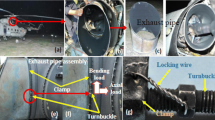Abstract
Investigations into a fatal helicopter crash centered around the failure of a cadmium-plated, non-conforming, steel screw in a fuel-control unit. The present study, which includes a critical evaluation of previous investigations, was undertaken with the aim of getting more definitive answers as to whether the screw failed in flight due to hydrogen-embrittlement or stress-corrosion cracking, or whether the screw failed due to liquid-metal embrittlement during a post-crash fire. Previous investigations had not resulted in any consensus regarding the mode of failure or whether the failure was responsible for the crash.
Similar content being viewed by others
References
J.H. Bickford: “An Introduction to the Design and Behavior of Bolted Joints,” 2nd ed., Marcel Dekker, New York, 1990.
D.W. Cameron: “Failures in Large Gas Turbines due to Liquid-Metal Embrittlement,” Mater. Charact., 1994, 33, pp. 37–43.
H.E. Ebert: “Liquid Metal Embrittlement of Flange Connector Studs in Contact with Cadmium,” Handbook of Case Histories in Failure Analysis, vol. 1, ASM International, Materials Park, OH, 1992, pp. 335–37.
S.P. Lynch: “Failures of Structures and Components by Environmentally Assisted Cracking,” Eng. Fail. Anal., 1994, 1, pp. 77–90.
A.J. de Marcay and W.G. Hoover: “Cadmium-Coated Fasteners Cause LME,” Mater. Perform., 1991, p. 67.
L. Raymond: “The Susceptibility of Fasteners to Hydrogen Embrittlement and Stress Corrosion Cracking,” Handbook of Bolts and Bolted Joints, J.H. Bickford and S. Nasser, ed., Marcel Dekker, New York, 1998.
M.H. Kamdar: “Liquid Metal Embrittlement,” Failure Analysis and Prevention, vol. 11, ASM Handbook, American Society for Metals, Metals Park, OH, 1986, pp. 225–38.
S.P. Lynch: “Metal Induced Embrittlement of Materials,” Mater. Charact., 1992, 28, pp. 279–89.
C.R. Brooks and A. Choudhury: Failure Analysis of Engineering Materials, McGraw-Hill, New York, 2002.
D.N. Fager and W.F. Spurr: “Solid Cadmium Embrittlement: Steel Alloys,” Corrosion, 1971, 27, pp. 72–76.
P. Gordon and H.H. An: “The Mechanism of Crack Initiation and Crack Propagation in Metal-Induced Embrittlement of Metals,” Metall. Trans. A, 1982, 13, pp. 457–72.
M.O. Speidel: “Branching of Stress Corrosion Cracks in Aluminum Alloys,” The Theory of Stress Corrosion Cracking in Alloys, J.C. Scully, ed., NATO, Brussels, 1971, pp. 345–53.
A.R. Elsea and E.E. Fletcher: “Hydrogen-Induced Delayed Brittle Failures of High-Strength Steels,” DMIC Report 196, Defense Metals Information Center, Battelle Memorial Institute, Columbus, OH, Jan. 20, 1964.
A.R. Troiano: “The Role of Hydrogen and Other Interstitials in the Mechanical Behavior of Metals,” Trans. ASM, 1960, 52, pp. 54–80.
T.J. Hughel: “Delayed Failure of Class 12.8 Bolts in Automotive Rear Suspensions,” SAE Technical Paper Series, 820122, Society of Automotive Engineers, Warrendale, PA, 1982, pp. 439–44.
Y. Asayama: “Metal-Induced Embrittlement of Steels,” Liquid and Solid Metal Induced Embrittlement, M.H. Kamdar, ed., American Institute of Mining, Metallurgical and Petroleum Engineers, Littleton, CO, 1984, pp. 317–31.
Author information
Authors and Affiliations
Rights and permissions
About this article
Cite this article
Lynch, S.P., Edwards, D.P. & Crosky, A. Failure of a screw in a helicopter fuel-control unit: Was it the cause of a fatal crash?. J Fail. Anal. and Preven. 4, 39–49 (2004). https://doi.org/10.1361/15477020420774
Received:
Revised:
Issue Date:
DOI: https://doi.org/10.1361/15477020420774




